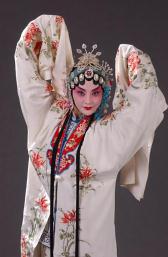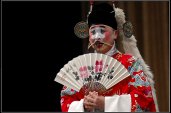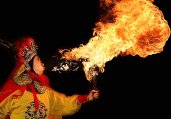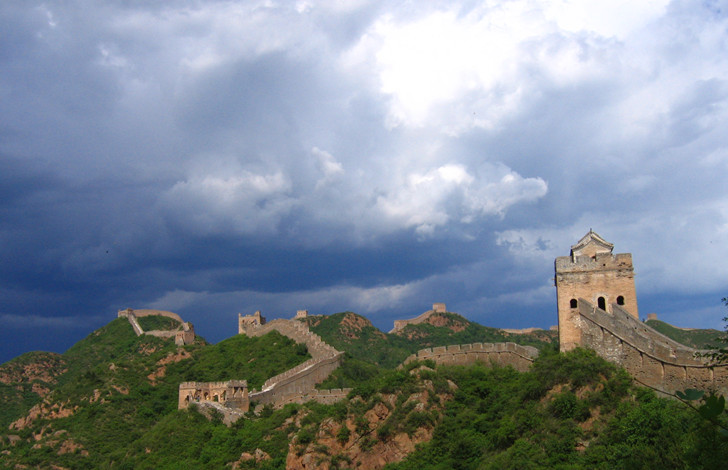
China Overview
- Population: 1.3 billion
- Currency: yuan
- Guinness World Records: most people painting each other's faces simultaneously in one location (13,413), largest bottle of cooking oil (containing 3212 litres), most couples hugging (3009 couples).
- Internet users: 135 million
- Milk beer: from Inner Mongolia, an alternative to the traditional mare's-milk wine.
- Squirrel fish: whole mandarin fish deep-fried and manipulated to resemble a squirrel.
- Number of chinese characters: over 56,000
Opera
Chinese opera is regarded as one of the most precious heritages of the Chinese traditional culture. The Chinese opera began to be enjoyed from the early period of the Three Kingdoms. After the Emperor Tang Xuanzong founded the “Pear Garden”, the first known opera troupe in China, this art form became more recognised. Until today, the operatic professionals are still referred to as “Disciples of the Pear Garden” in Chinese. When listening to the Chinese opera, one can enjoy art forms such as folk songs, dances, talking, antimasque, and especially dialectical music at the same time. It is a good combination of music, art and literature. Accompanied by traditional musical instruments like the Erhu, the gong, and the lute, actors present their unique melodies. But these melodies may be “too noisy” for foreigners. Even the dialogues are beautifully written and of high literary value. These dialogs also promoted the development of distinct literary styles, such as Zaju in the Yuan Dynasty. For Chinese people the older generation in particular, the opera is a real pleasure. |
| A general introduction to Beijing Opera When people hear about the Chinese opera, they immediately think of the Beijing Opera. This traditional Chinese opera is a national treasure and combines music, vocal performance, mime, dance and acrobatics.It has a long history of 200 years. In 1790, in order to perform for the birthday of the Emperor Qianlong, many theatre companies from all over China arrived in |
|
, Beijng.Four Anhui theater companies brought their fresh styles of music and theatre to the capital. They combined their opera with those from Hebei, Wuhan and Shanxi. Afterwards, there was a new form of opera in Beijing – “Capital Play”. That’s what we call “Beijing Opera” today. | |
Facial Painting There are various figures in the Beijing Opera, all with different characteristics and images. In order to show the differences, performers must put colourful dressing on their faces. The facial painting is formed through performers’ long-term practice as well as their understanding and judgment of the roles in plays. By using transformative and exaggerated figures, professional spectators can easily tell the characteristic of a role.In this way, the facial painting is called “the picture. |
|
of hearts”There are various consistencies in the facial painting in the aspect of colour, type and shape. Usually, eyes, foreheads and cheeks are painted like wings of butterflies, swallows and bats. | |
Main roles in the Beijing Opera In the Beijing Opera, there are generally four main roles: Sheng (the male roles), Dan (the female roles), Jing (the painted face roles), and Chou (clowns). An actor is typically only trained for one type of role within one category. He or she almost never plays roles outside his or her category. Actors who are able to play multiple types of roles within a single category are considered especially talented. |
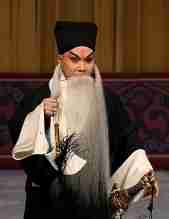 | 1. Sheng Laosheng refers to the middle-aged or old man. They often wear beard and sensible costumes to show their dignity. Actors who play this role are usually high level scholars or officials. The young artists usually play the role of Xiaosheng. They don’t have a beard and usually sing in a high, shrill voice with occasional breaks to represent the voice changing period of adolescence.Wusheng portrays the most exciting elements |
of Chinese Opera. A well-known example of Wusheng role is the Monkey King, featured in a number of operas based on the famous story A Journey to the West. | |
2. Dan The Dan refers to any female role in Beijing opera. There are much more female role types as there are male, even though women didn’t have an equal status as men in ancient China. Because of the different characters, status, and ages, the role of Dan is divided into Laodan, Wudan, Daomadan, Qingyi and Huadan. Laodan refers to old females who don’t wear any make-up on their face. They sing in their natural voice which is much lower than other roles of Dan. Wudan refers to martialistic women and is equivalent to the Wusheng role for the men. Young female warriors are Daomadan. This character typically wears full |
|
armour and great peacock feathers in her hat. Qingyi actress is the virtuous and elite noblewoman. These faithful, proper, shy and graceful women are regarded as the model or ideal of the Chinese woman. The social status of Huadan is lower than any other female roles. They are vivacious and often unmarried. This role represents a feistier, flirtatious young woman. | |
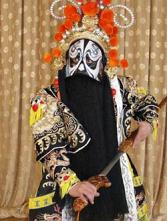 | 3. Jing During this part of the Beijing Opera, a white face means treachery, black means honesty, red indicates courage and virtue, and blue denotes cruelty or wild temperament. A mix of multiple colours indicates a more complicated personality. The characters of Baozheng and Caocao are typical representatives of Jing. |
4. Chou Chou has the same meaning as clown and can be either male or female. Male clowns all wear a white patch of make-up around the nose and eyes, while female clowns usually have a reddened face with black eyebrows. The role of Chou is divided into two categories: Wen Chou and Wu Chou. These mean the roles are of merchants or minor militant roles respectively. They perform with comic acting, acrobatics, and a strong voice. |
|
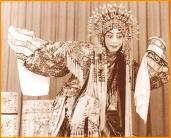 | Famous Beijing Opera Artists Mei Lanfang was born into a family of Kunqu performers. He first performed when he was just 10 years old. His most famous characters are the Qingyi roles. His skilful portrayal of women won him an international acclaim. |
Because of his smooth,perfectly timed, poised style, a “Mei School” was gradually introduced in the circle of Chinese Opera. Mei also worked hard to create new performance skills. One of his most important contributions to Beijing Opera was the creation of Dan, the Huashan. This role type combines the status of the Qingyi with the sensuality of the Huadan Shang Xiaoyun was famous for his dance and acrobatic skills as well as his singing. Cheng Yanqiu was the creator of several original productions of the Beiing Opera. Xun Huisheng is best known for his effective portrayal of Huadan roles. | |
Are there any other forms of Chinese Opera? |
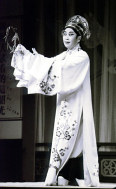 | Kunqu |
Sichuan Opera The province Sichuan is the birth place of this art form. The Sichuan Opera began during the early period of the Three Kingdoms. Its less constrained singing of Sichuan Opera makes it different from other Chinese Operas. It is more like a play and the acting is highly polished. Sichuan Opera is well known for the performance of face-changing, sword-hiding, and fire-spitting |
|
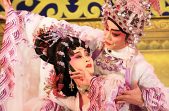 | Cantonese Opera |
It effectively gives the audience an insight into the culture and philosophies of the Chinese people in the play: loyalty, moral, love, patriotism and faithfulness. | |
All Topics about China
- General-China-Introduction
- C2-Chinese-History
- Chinese-Religions
- Chinese-Food-and-Drink
- Chinese-Literature
- Chinese-Nationality
- Chinese-Architecture
- Chinese-Arts-and-Crafts
- Chinese-Language-and-Education
- Chinese-Medicine
- Chinese-Transportation
- Chinese-Festival
- Chinese-Astrology-and-Zodiac
- Chinese-Calendar
- Chinese-Traditional-Sports-&-Activities
- Chinese-Martial-Arts
HOTMost Popular Topics
Climate in China
Because of its size, China has great climatic diversity. Generally, the best time to visit China is during spring and autumn.
Chinese-Language-and-Education
Chinese is the most commonly used language in China, and one of the most commonly used languages in the world.
Chinese-Festival
China has many traditional festivals, including the Spring Festival, the Lantern Festival, the Dragon Boat Festival.
Chinese Chinese-Astrology-and-Zodiac
In the Chinese zodiac, twelve animals are used to denote the year of a person's birth: rat, ox, tiger, rabbit, dragon.
History of China
China, one of the world's most ancient civilizations, has a recorded history of nearly 4,000 years..
0716q.jpg)
0716q.jpg)
